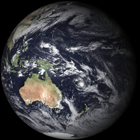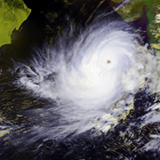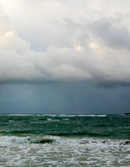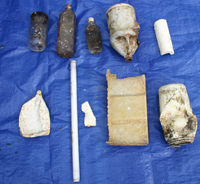Press Releases 2012
Tropical Indo-Pacific Climate Shifts to a More El Nino-Like State
Honolulu, November 14, 2012
 Climate models predict a slowdown of the Walker circulation with global warming. Atmospheric models, however, have failed to reproduce the slowdown already observed over the last 60 years, casting doubt on their ability to simulate slow climate change. Now a study spearheaded by IPRC's Hiroki Tokinaga in this week's issue of Nature has succeeded in simulating the slowdown and shows that changes in the sea surface temperature pattern across the Indo-Pacific are the cause. Read press release.
Climate models predict a slowdown of the Walker circulation with global warming. Atmospheric models, however, have failed to reproduce the slowdown already observed over the last 60 years, casting doubt on their ability to simulate slow climate change. Now a study spearheaded by IPRC's Hiroki Tokinaga in this week's issue of Nature has succeeded in simulating the slowdown and shows that changes in the sea surface temperature pattern across the Indo-Pacific are the cause. Read press release.
Uncertainty of Future Pacific Island Rainfall Explained
Honolulu, October 28, 2012 With greenhouse warming, rainfall in the South Pacific islands will depend on two competing effects – an increase due to overall warming and a decrease due to changes in atmospheric water transport – according to a study by an international team of scientists around IPRC’s Matthew Widlansky and Axel Timmermann. In the South Pacific, these two effects sometimes cancel each other out, resulting in highly uncertain rainfall projections. Results of the study are published in the 28 October online issue of Nature Climate Change. Read press release.
With greenhouse warming, rainfall in the South Pacific islands will depend on two competing effects – an increase due to overall warming and a decrease due to changes in atmospheric water transport – according to a study by an international team of scientists around IPRC’s Matthew Widlansky and Axel Timmermann. In the South Pacific, these two effects sometimes cancel each other out, resulting in highly uncertain rainfall projections. Results of the study are published in the 28 October online issue of Nature Climate Change. Read press release.
Department of Interior Awards Over One Million Dollars to UH Manoaand Hilo for Climate Studies

Honolulu, October 10, 2012
Today Interior Secretary Ken Salazar announced the funding for the 69 nationwide projects of the recently established Climate Science Centers. Among the 5 projects funded for the Pacific Islands Climate Science Center are two spearheaded by IPRC scientists: Climate Change Research in Support of Hawaiian Ecosystem Management: An Integrated Approach, led by Oliver Elison Timm, and 21st Century High-Resolution Climate Projections for Guam and American Samoa, led by Yuqing Wang. Read press release.
Earlier Monsoon Onset Impacts Tropical Cyclones in Arabian Sea
September 24, 2012
The tropical cyclones in the Arabian Sea during the pre-monsoon season
May – June) have intensified since 1997 compared to 1979 - 1997. This is the result of decreased vertical wind shear due to a 15-day on average earlier occurrence of tropical cyclones and an earllier monsoon onset, according to a study spearheaded by Bin Wang at the International Pacific Research Center, University of Hawaii at Manoa and published in "Brief Communications Arising" in the September 20, 2012, issue of Nature.
Read press release.
NASA’s Martian Weather Reports Reveal Extreme Pressure Swings
September 19, 2012
Curiosity, the NASA rover that landed on Mars last month, is sending us remarkable weather observations from the Martian surface. “The exciting new result from Curiosity is a regular and truly enormous swing in atmospheric pressure through each day. Measurements on Earth show a daily swing in pressure of only about one-tenth of 1% of the mean pressure, whereas Curiosity is measuring swings of almost 10% of the daily average pressure,” says IPRC Director Kevin Hamilton, a pioneer in the area of computer modeling of the Martian atmosphere. “These results confirm a theoretical prediction I made years ago that the daily cycle on Mars could be amplified by a global resonance of the atmosphere.”(read press release)
Climate Change and the South Asian Summer Monsoon
Honolulu, June 25, 2012 
The vagaries of South Asian summer monsoon rainfall impact the lives of more than one billion people. Based on an extensive review of recent research, IPRC’s H. Annamalai and A. G. Turner from the University of Reading in the UK, conclude that with continued rise in CO2 the region can expect generally more rainfall. Regional projections for devastating droughts and floods, however, are still beyond the reach of current climate models. Their review is in the June 24 online edition of Nature Climate Change. Read release.
Unprecedented, Man-made Trends in Ocean's Acidity
Honolulu, January 22, 2012
Recent carbon dioxide emissions have pushed the level of seawater acidity far above the range of the natural variability that existed for thousands of years and are affecting the calcification rates of shell-forming organism, according to a study of an international team of scientists led by IPRC's Tobias Friedrich and Axel Timmermann. Their study appears in the January 22 online issue of Nature Climate Change.
Tsunami Debris Survey Launched Northwest of Midway
Honolulu, January 25, 2012 
The March 11, 2011 earthquake northeast of Japan and the impact of the subsequent tsunami wave on the Tohoku coastline produced as much as 25 million tons of debris. A large amount of the debris was released into the ocean. Under the influence of winds and currents, floating debris is dispersing over a large area and drifting eastward; it is predicted to reach Hawaii and the West Coast of the United States within the coming two years. In order to obtain some certainty about the model predictions, an expedition was made to survey the ocean northwest of Midway during December. Read more about the survey.
News Archive: 2013, 2012, 2011, 2010, 2009, 2008, 2007, 2006, 2004, 2003, 2002, 2001, 2000

